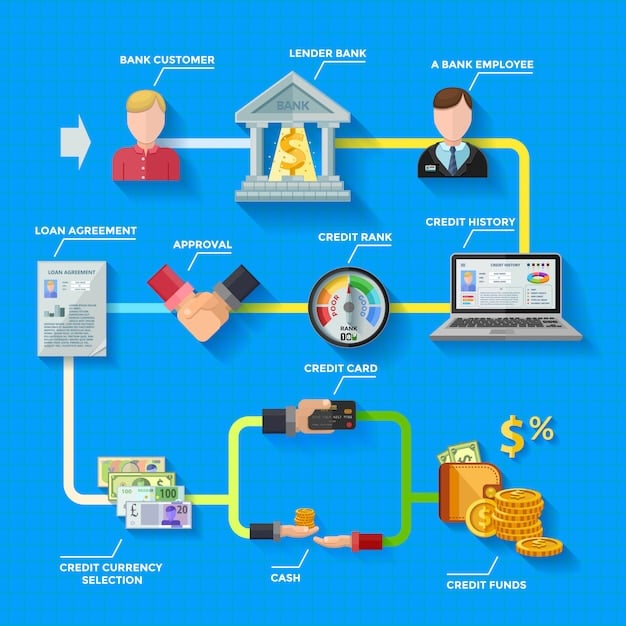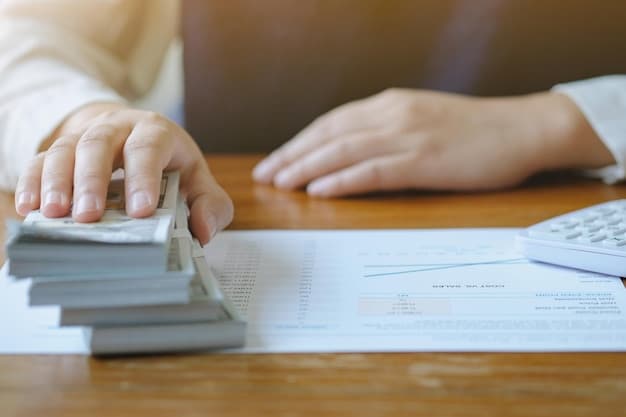Student Loan Forgiveness: A Step-by-Step Guide & Common Mistakes

Navigating the complexities of student loan forgiveness can be daunting; this guide simplifies the application process and highlights common pitfalls to avoid, ensuring a smoother path toward debt relief.
Are you burdened by student loan debt and seeking relief? Understanding the process of student loan forgiveness: How to navigate the application process and avoid common mistakes is crucial for accessing potential debt relief programs. This guide will walk you through each step, offering clarity and practical advice.
Understanding Student Loan Forgiveness Programs
Student loan forgiveness programs offer a pathway out of debt for borrowers who meet specific criteria. These programs are designed to help individuals in public service or those with qualifying circumstances manage their student loan obligations. Learning about the different types of programs is a critical first step.
Federal Student Loan Forgiveness Programs
Several federal programs offer loan forgiveness. These are typically tied to specific employment sectors or require a certain repayment plan.
- Public Service Loan Forgiveness (PSLF): For those working in government or qualifying non-profit organizations.
- Teacher Loan Forgiveness: Available to qualified teachers in low-income schools.
- Income-Driven Repayment (IDR) Forgiveness: For borrowers on certain income-driven repayment plans.
State and Other Loan Forgiveness Options
Beyond federal programs, some states and organizations offer loan forgiveness assistance. These programs are often targeted towards specific professions or geographic areas.

In summary, loan forgiveness programs provide a potential lifeline for eligible borrowers struggling with student loan debt. It’s essential to research and understand the requirements of each program to determine the best fit for your situation.
Determining Your Eligibility for Forgiveness
Before diving into the application process, it’s paramount to determine if you meet the eligibility criteria for the relevant forgiveness programs. Eligibility can vary greatly depending on the specific program and your unique circumstances. Thoroughly checking eligibility is the first step to reduce frustration and make sure you apply for the right plan.
Key Factors Influencing Eligibility
Several factors influence your eligibility for student loan forgiveness. These include your employment, loan type, and repayment plan.
- Employment Type: Many forgiveness programs, like PSLF, require specific types of employment in public service or non-profit sectors.
- Loan Type: Federal Direct Loans are typically eligible for the most forgiveness programs.
- Repayment Plan: Some forgiveness programs require you to be enrolled in an income-driven repayment plan.
Using Online Tools and Resources
Online tools, such as the Department of Education’s Loan Simulator, can help you estimate potential loan forgiveness and assess your eligibility for various programs.
Eligibility depends on identifying the important factors and comparing these to the standards of possible forgiveness programs. Making use of online tools and resources will allow you to make more well informed decisions.
Gathering Necessary Documentation
Once you’ve determined your eligibility, the next crucial step in applying for student loan forgiveness is gathering all the necessary documentation. Having everything organized and readily available can streamline the application process and minimize potential delays or rejections. Make sure that nothing is missing to ensure a seamless process.
Common Documents Required
Here’s a list of common documents you may need during the application process. Ensure you have these in order.
- Loan Account Statements: Detailed records of your federal student loans, including loan types and outstanding balances.
- Employment Certification Forms: Required by programs like PSLF to verify your employment in a qualifying public service sector.
- Income Documentation: Including tax returns, W-2 forms, or pay stubs, especially if you’re applying for income-driven repayment forgiveness.
Where to Find These Documents
You can usually obtain loan account statements from your loan servicer’s website. Employment certification forms can be downloaded from the Department of Education’s website, and your employer will need to complete them. Income documentation can be retrieved from your tax records.

Gathering the necessary documentation is a proactive measure that saves time and reduces stress during the application process. By having all required documents ready, you’re one step closer to obtaining student loan forgiveness.
Completing the Application Accurately
After compiling all the required documentation, the next pivotal step in the student loan forgiveness journey is to complete the application accurately. The application is frequently available online. To make sure that you don’t make any errors or omissions, read all of the directions before filling out the form.
Step-by-Step Application Instructions
The application procedure usually varies somewhat across programs, but there are some important steps that remain constant.
- Read Instructions Carefully: Each forgiveness program features its own unique requirements and instructions.
- Fill Out All Sections: Ensure every section of the application is completed with accurate information. Leaving fields blank can cause delays or denials.
- Double-Check for Errors: Review the completed application thoroughly before submission to catch any potential errors or inconsistencies.
Tips for Avoiding Common Mistakes
Some mistakes like, missing deadlines, providing incorrect or insufficient information, and not keeping copies of your submission are common when applying for forgiveness for student loans.
The completion of the application precisely can determine whether or not your student loan is accepted. To improve your chances of acceptance, take your time, pay attention to detail, and stay organized.
Submitting Your Application and Following Up
After carefully completing the application, the next step is to officially submit it. This process involves ensuring that you adhere to specific guidelines depending on the program you’re applying for. Additionally, after submission, it’s essential to proactively follow up to track the progress of your application and address any further requests from the loan servicer.
Submission Methods and Deadlines
The application must be submitted via the means defined by the program. Some online sites permit electronic submissions, while other programs demand that paper copies be mailed in by a certain date. Pay attention to the deadlines to make sure you submit your application on time.
Tracking Your Application Status
Following submission, keep an eye on your application to be informed about your status. Use the servicer’s online gateway, track it via emails, and check the status frequently.
Submit your application in accordance with the designated requirements and, after doing so, carefully monitor its progress. Stay dedicated to the process and be ready to reply to any requests.
Understanding Potential Denial Reasons
Although the majority of people dream about student loan forgiveness, there are nevertheless dangers in the form of possible denial reasons. Knowing why a loan is rejected is helpful. Let’s examine some frequent reasons why people are turned down so that you may address possible problems with your application.
Common Reasons for Forgiveness Denial
Understanding why your application may be denied can help you avoid common pitfalls and increase your chances of success.
- Incomplete Application: Missing sections or incomplete information can lead to denial.
- Eligibility Issues: Not fulfilling the specific criteria for the forgiveness program.
- Documentation Errors: Errors in your documentation can trigger denials.
How to Address a Denial
If your application for student loan forgiveness is denied, you have the right to appeal the decision. Start by requesting an explanation for the denial and reviewing your application for any errors or omissions. Gather any additional documentation that may support your case and submit an appeal following the instructions provided by your loan servicer.
Being aware of the factors for denial enables you to remedy any mistakes and improve your chances. If necessary, appeal the rejection with any supporting paperwork. By addressing difficulties prospectively, you may stay on track to getting student loan forgiveness.
| Key Point | Brief Description |
|---|---|
| ✅ Eligibility Check | Confirm your eligibility for specific forgiveness programs. |
| 📝Gather Documents | Collect loan statements, employment certifications, and income documentation. |
| ✍️ Accurate Application | Complete all sections meticulously and double-check for errors. |
| 📅 Follow-Up | Track your application status and respond to servicer requests promptly. |
Frequently Asked Questions
▼
PSLF forgives the remaining balance on your Direct Loans after you have made 120 qualifying monthly payments while working full-time for a qualifying employer.
▼
You may be eligible if you teach full-time for five complete and consecutive academic years in a low-income elementary or secondary school.
▼
IDR plans set your monthly student loan payment at an amount that is intended to be affordable based on your income and family size.
▼
Qualifying employers include government organizations (federal, state, local, or tribal) and certain non-profit organizations that are tax-exempt.
▼
If your application is denied, review the reason for denial, correct any errors, gather additional documentation, and consider appealing the decision.
Conclusion
Navigating the student loan forgiveness process can seem complex, but with careful planning and attention to detail, you can increase your chances of success. By understanding eligibility requirements, gathering necessary documentation, completing the application accurately, and following up diligently, you can take proactive steps toward achieving debt relief. Always stay informed and seek professional advice when needed to make the best decisions for your financial future.





